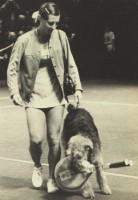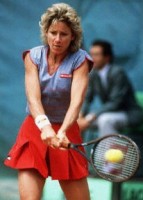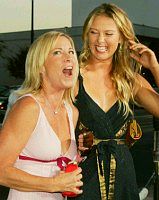Out of print, but still readily obtainable used from Amazon.com via the link above.
|
Other players (pages 102-104) Betty Stove of the Netherlands intimidated me at first with her size. At 6 feet 1 inch, she was strong and rangy, with a first serve that could knock you down and an impulsive, hard-to-read serve-and-volley game. Off the court, Betty was thoughtful, practical and independent enough to have been elected president of the Women's Tennis Association. If she had dedicated herself 100 percent to tennis, she might have been one of the game's greatest players, but there were other interests that counted as enjoyment to her, and this ambivalence was probably the reason why she could be funny one day and withdrawn the next. ...Kerry [Melville of Australia] was quiet, friendly and fun loving. If you teased her, she would blush a lot; over the years, I enjoyed telling her dirty jokes just to see her face turn red. Nothing fazed Olga Morozova, which again proved that you can't judge people by stereotypes. Soviet athletes were supposed to be intense and mysterious, but Olga was delightfully free-spirited, considerate, a better athlete than tennis player. She was married to an engineer but kept her maiden name, grew up on clay courts but preferred serve-and-volley and spoke better English than some Americans. After she beat Rosie [Casals] in three sets and Billie Jean [King], 7-6, 6-1, at the Slims event in Philadelphia, one local writer became infatuated with her. He had watched her all week, listened to her postmatch press conference and couldn't understand how she could play so well, coming from a country that thumbed its nose at tennis. "Are there any places to play tennis in Russia during the winter?" he finally asked. Olga gave the writer an incredulous look. "You think we come from the moon?" she said. Everyone at the news conference roared. | |
|
...Françiose Durr made everyone laugh. "Frankie," as everyone called her, was easily the best French player in several decades, and her personality was as colorful as the crazy, unorthodox backhand that she hit with her right arm out in front of her body like a board. Frankie continually talked to herself on the court; the fact that you couldn't tell whether it was English, French or a combination made her comments more amusing. ...On some occasions, Frankie even had her terrier dog, Topspin, carry her racquets onto the court... Françiose Durr & "Topspin" in 1973, photo from A Long Way, Baby
|
 |
|
Virginia Slims of Houston, 1976 (pages 121-122) The morning of the first Slims final in Houston... Jeanie [Brinkman, of the WTA] decided to throw a little brunch in her room. About a dozen of the players showed up, including Rosie [Casals], Olga [Morozova] and another Soviet player, Natasha Chmyreva. So did Martina [Navratilova] and I, who just happened to be playing in the final later that day. ...But I was never in the match against Martina and lost, 6-3, 6-4. I was so relaxed that I couldn't bring myself to concentrate against a serve-and-volley player whose strongest surface was a Sporteze indoor carpet... What made the situation more touchy was that I had to return to the locker room, change clothes and play the doubles final with Martina as a partner, against Rosie and Frankie Durr. The tension was still there. Although we were top-seeded, Martina and I were blitzed in the first set, 6-0, and lost the second, 7-5. After the match, Frankie's dog, Topspin, sauntered out to take her racquets off the court. Instinctively, Martina grabbed my racquet, put it in her mouth and walked off behind Topspin. I fell over with laughter; Martina's spontaneity had melted my ice from earlier in the day. |
|
"Ladies of the Evening" (pages 116-117) You won't find the "Ladies of the Evening" results in any USTA Media Guide... The idea blossomed during the Family Circle Cup at Amelia Island, Florida in 1975... Rosie Casals was more instrumental than anyone in getting the two "ladies of the evening," Peaches Kellmeyer and Vickie Berner, into a "championship match." Both were former players turned tour directors, whose after-hours reputations (Peachy with Michelob, Vickie with Dewar's Scotch) had reached legendary proportions. Of course, Rosie could not just have Peachy and Vickie play a routine match. There had to be other conditions. On court changeovers, for example, Peachy was required to take a swig of beer while Vickie downed Scotch... Billie Jean, naturally, was the umpire, wearing two pairs of glasses, and Martina and I were designated as "coaches." ...Betty Stove and Frankie Durr were ball girls, and others called lines. When Vickie started winning, the linesmen simply ignored her serves and called faults. ...We had a cookout after the match, which Vickie won, and then decided that "Ladies of the Evening" would become a permanent fixture on the circuit. The following year, we staged it as a doubles event in Los Angeles, after the Slims final. Nobody could remember much from that party after eating Rosie's brownies. In 1977, we rented the discothèque at the Hilton Hotel in Philadelphia and put on a series of hilarious skits and dance numbers. I was the master of ceremonies at that bash, in a Groucho Marx costume. Rosie served her famous brownies that night too. |

|
1976 Wimbledon final: Chris Evert d Evonne Goolagong 6-3, 4-6, 8-6 (pages 137-140) ...Evonne had taken the Slims title and was riding a twenty-five match winning streak. ...I took the first set 6-3, steadier off the ground, Evonne won the second 6-4, and then opened a 2-0 lead in the third until I got back a service break and we went to 4-all. That's when I looked up in the Friends Box and saw Billie Jean and Rosie motioning with their eyes. At first, I couldn't figure out what they were trying to tell me; then it dawned: They wanted me to move into the net and attack Evonne's second serve. If Evonne held her serve now, it would leave me serving at 4-5, but if I broke I could serve for the match... "Never change a winning game," was a tennis motto, but if I didn't take some chances and change Evonne's rhythm, she could serve and volley her way straight to the title. I didn't exactly look like Tony Roche rushing to the net in the ninth game. But my aggressiveness in chipping to Evonne's forehand threw her off enough for her to miss several passing shots. I broke to 5-4 and needed only to hold serve for a second Wimbledon title. On the court changeover, I should have been thinking just as aggressively. Instead, I retreated, lost my serve at love and then sat back and watched Evonne carry the momentum to a 6-5 advantage. Sitting at mid-court, I toweled off and went back to several basics: Get your first serve in, preferably to Evonne's forehand; stay keen... Evonne helped rebuild some of my confidence. On the first point of the twelfth game, she rushed the net with an approach shot to my backhand. If I held back anything, she would be in perfect postion for a finishing volley, so I leaned forward and drove the ball cross-court with a ferocity that bordered on recklessness. The pace of the shot stunned her because she mishandled the volley, and I held serve from 15. At many tournaments, 6-all in the third set means a decisive tie breaker. Not Wimbledon. Evonne and I would go on under conventional scoring until one of us took two consecutive games... Evonne had chances to hold for 7-6, but I attacked and won the point with an overhead and then broke on two errors. I had served once for the match and squandered the advantage. Here I was again. At 30-0, Evonne won the next two points, but I reached 40-30. Evonne moved in behind a forehand volley down the line. Anticipating my two-handed cross-court drive, she crowded closer to the net, leaning and waiting. Instead of the passing shot, however, I held my two-handed backhand as long as I could, and then, with the same motion as my drive, flicked a topspin lob crosscourt, over Evonne's left shoulder. The ball landed a foot or so inside the baseline. Game, set and match. I must have thrown my Wilson racquet fifty feet in the air... The high racquet toss after match point at Wimbledon, 1976 photo from Chrissie |
|
The 2-handed backhand & Chrissie's serve (pages 46-48) I never took up a two-handed backhand to copy [Mike] Belkin, Peaches Bartkowicz, or Eddie Dibbs, another Floridian. My father stood at the net and threw balls to me. I was on the other side, in the middle of the court, when he would say, "Racquet back, turn sideways, follow through." He said those same lines every day for years. The more proficient I became, the farther back I moved on the court. There was no way I could hit balls over the net on my left side with one hand. The racquet was too heavy. My dad tried one experiment at converting me to a one-handed backhand. I was nine years old, and the experiment lasted about a week... There are advantages and disadvantages to the two-handed backhand. Because both hands are involved, it forces a player to prepare earlier and bend the knees; a player thus has better racquet preparation, steadier body position, more time for disguise and pace and more control over the shot. The backswing can also be stylized: Bjorn Borg, for example, has a long, exaggerated swing, in which he brings the racquet back slightly below his knees and close to his side with a small loop on the way back and both wrists cocked downward for topspin; Jimmy Connors brings his racquet straight back, with a firm straight wrist; I also hit a flatter stroke than Borg, with my racquet almost parallel to the court on the backswing. The prescence of the left hand above the right (the situation is reversed for left handers) gives the two-handed backhand stability and power. But the key factor is flexibility: With the two-handed backhand, even if the ball is behind you, the early racquet preparation allows for sufficient recovery to lob offensively, or hit a reflex ground stroke. The disadvantages of the two-handed shot involve technical adjustments. Players who become too dependent on two hands never learn how to volley under stress. It's also more difficult to dig out short balls hit to the backhand because the instinct of the two-handed player is to drive rather than slice. Anticipation is essential for getting to short balls before they are unplayable. With two hands, lifting over low balls on surfaces like grass and clay can be troublesome. ...My serve has never been a weapon on the court. But nobody has ever attacked it either, and my serve may be the most underrated phase of my game. A hard, fast serve can be a plus or a minus depending on how it fits into your game. Many players hit their first serve at ninety miles an hour, their second serve at forty-five miles an hour and wonder why they lose a point. You're better off slowing down your first serve and speeding up your second. My dad always stressed the importance of getting in 70 to 80 percent of my first serves. "When you get the first ball in," he would tell me, "it means you're loose and playing with confidence. When you start missing that first ball, other things will start going wrong." |
Excerpt from Lloyd on Lloyd by Chris [Evert] and John Lloyd with Carol Thatcher, 1985, Beaufort Books, NY
Out of print, but still readily obtainable used from Amazon.com.
Lloyd on Lloyd was written about 3 years after Chrissie. Despite the book's title, it is not written in the first person. Instead, coauthor Carol Thatcher, daughter of Margaret Thatcher (then Prime Minister of Britain) describes the Lloyds in the 3rd person. This book was aimed primarily at a British audience, due to the fact that John Lloyd is British, and was possibly the most popular British player at the time. This book overlaps considerably the information in Chrissie, but with much more emphasis on her relationship with Lloyd, and without the interest generated by a first person narrative. Lloyd on Lloyd cannot be recommended.
|
Early years (pages 19-25) Chris wasn't at all keen when her father announced to her that she was starting tennis lessions... "I was hurt and crushed that my father took me away from my fun to throw tennis balls at me," she remembered. He instilled concentration and timing into her: "I heard the same four phrases -- 'racket back, turn sideways, watch the ball, follow through' -- over and over again for two years," she said... Chris competed in her first tournament the week of her eighth birthday at the annual Orange Bowl, staged at Flamingo Park, Miami Beach, the world's premier junior event, where she won the doubles with partner Bonnie Smith... Chris won the national fourteen-and-under singles in 1968 and thought there was already something automatic about her tennis playing. "I felt, 'wind me up and I'll walk on court,'" she said... Chris's breakthrough, which astonished her parents and the tennis world, came in North Carolina when she was fifteen [1970] and beat Margaret Court, thirteen years her senior and the no. 1 in the world. Only weeks before, Margaret had won the US Open which gave her the coveted Grand Slam making her the only the second woman after Maureen Connolly in 1953 ever to have achieved the feat of winning the four Grand Slam events in one year. ..."I played Françoise Durr and beat her 6-1, 6-0 and everybody was shocked," Chris said... Durr was ranked no. 2 in the world on clay... The following day in the semifinals Chris played Margaret Court, the formidable Australian, a powerful athlete who had won Wimbledon in 1963, 1965 and 1970... "I always felt sick to my stomach when I had to play girls my own age, but when I played someone ten years older I thought that if I didn't win I still had ten more years.. "I had nerves of steel that day, and I beat her 7-6, 7-6. It was a hell of a match; my groundstrokes and passing shots were great..." Mr and Mrs Evert flew up to Charlotte to watch Chris the in the finals the next the following day in which she played Nancy Richey... Chris lost the match 6-4, 6-1. ...Nancy was the first of only three players in Chris's entire career who have built up runs of consecutive victories over her. Tracy Austin was the second in 1979-80 and Martina Navratilova the third in 1982-5... |
|
Between 1970 and 1989, Chris Evert won 157 singles titles, including 18 Grand Slam singles titles. Chris was born in Fort Lauderdale, Florida on December 21, 1954. Her father, Jimmy Evert, who had grown up in Chicago, Illinois during the Great Depression, was a very good tennis player who had reached the round of 16 of the US Nationals. Chrissie turned pro in 1973, and by 1976 had become the first player ever to win over $1 million in prize money. In 303 tournaments entered, Chris won 1,309 singles matches while losing only 146. Her winning average of .8996 is the highest in pro history, carrying Chrissie to the final in 76% of the tourneys she entered. Evert was ranked # 1 in the world in 1975, 1976, 1977, 1980, & 1981, and was ranked in the world's top 10 for 17 years. Chrissie at the 1986 French Open |

| |
ChrisEvert.net: Chris Evert History
ChrisEvert.net: Chris Evert Record
Find more books by or about Chris Evert at Amazon.com
Find tennis shoes made by: adidas -- Nike -- Fila -- Reebok
Find tennis racquets made by: Yonex -- Wilson -- Head -- Prince -- Babolat
Find tennis balls made by: Wilson -- Dunlop -- Penn -- Tretorn -- Slazenger
Tennis pages at quickfound.net:
- Tennis History Book Excerpts:
Chrissie: My Own Story by Chris Evert with Neil Amdur
Courting Triumph by Virginia Wade with Mary Lou Mellace
Tennis Styles and Stylists by Paul Metzler
The Game by Jack Kramer about Pauline Betz & Gussy Moran & more
Beyond Center Court: My Story by Tracy Austin with Christine Brennan
Courting Danger by Alice Marble with Dale Leatherman
Evonne!: On the Move by Evonne Goolagong with Bud Collins
Court On Court: A Life in Tennis by Margaret Smith Court
Goddess & the American Girl: Suzanne Lenglen & Helen Wills by Larry Englemann
Hard Courts by John Feinstein about Mary Carillo & John McEnroe & more
Ladies of the Court by Michael Mewshaw about Mary Joe Fernandez & more
A Long Way, Baby by Grace Lichtenstein about Rosie Casals
Tough Draw by Eliot Berry about Nick Bollettieri
Monica by Monica Seles & My Aces, My Faults by Nick Bollettieri Seles at Bradenton
The Courts of Babylon by Peter Bodo: Tournament Draws
The Courts of Babylon by Peter Bodo: Dawn of the Pro Tours
- Tennis Articles
1946 TIME: Pauline Betz, Doris Hart, Beverly Baker, Gussie Moran
plus current tennis article feed
1951 & 1952 TIME: Maureen Connolly - Tennis News and Links
- WTA 2004 Desktop Wallpaper
- Justine Henin-Hardenne Desktop Wallpaper
- Maria Sharapova Desktop Wallpaper
- Anastasia Myskina Desktop Wallpaper
- Anna Kournikova News and Links
- Anna Kournikova Desktop Wallpaper
- Martina Hingis News and Links
- 2004 WTA Player Interview Videos
This page's URL is: //tennis.quickfound.net/history/chris_evert.html
